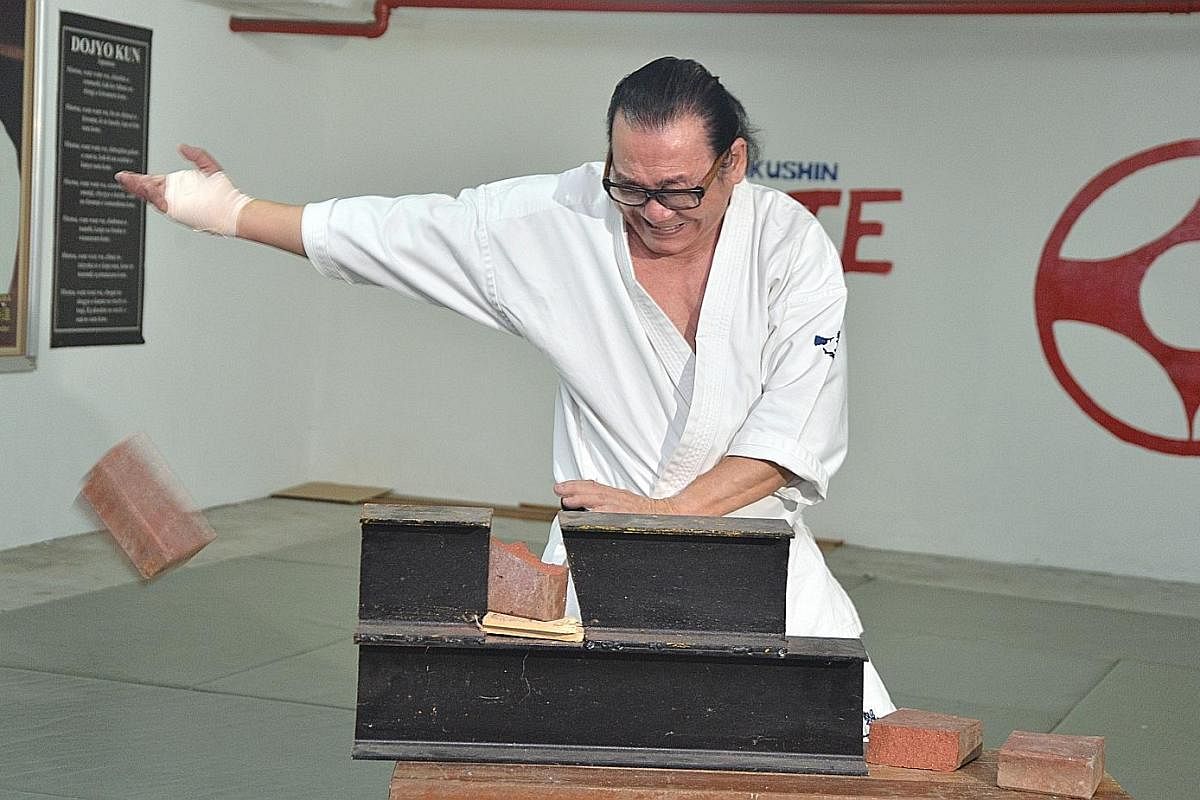-
Asian Restored Classics 2017
-
TAIPEI STORY
110 minutes, NC16, 1985, Mandarin and Hokkien
What: Feted director Hou Hsiao- hsien is an actor here along with pop singer Tsai Chin - they play childhood sweethearts navigating life in contemporary Taipei. He was nominated for a Golden Horse Award for his turn as a former baseball player in the late Edward Yang's second feature. When: Aug 31, 8pm Where: Capitol Theatre
THE SURROGATE WOMAN
100 minutes, M18, 1987, Korean
What: Kang Soo Yeon was named Best Actress at the Venice Film Festival for playing a servant girl chosen to be the surrogate for a nobleman whose wife has not been able to conceive a male heir. Renowned director Im Kwon Taek's period drama highlighted the plight of women in Korean society. When: Sept 1, 8pm Where: Capitol Theatre
CARMEN COMES HOME
103 minutes, PG, 1951, Japanese
What: A musical comedy about a Tokyo stripper who causes a stir when she returns to her rural hometown. The lead actress, Hideko Takamine, was a child actress billed as Japan's Shirley Temple who became the country's top star in the 1950s and early 1960s. When: Sept 2, 4pm (double bill with Senninbari) Where: Capitol Theatre
SENNINBARI
19 minutes, PG, 1937, Japanese
What: A boatman's engagement is disrupted when he is packed off to war in China in this incomplete print of Japan's oldest surviving colour talkie. When: Sept 2, 4pm (double bill with Carmen Comes Home) Where: Capitol Theatre
FIST OF FURY
108 minutes, 1972, PG13, English, Cantonese and Mandarin
What: Legendary action star Bruce Lee teams up with director Lo Wei again after The Big Boss (1971), Lee's breakthrough film. He plays Chen Zhen, a young martial artist who investigates his master's suspicious death and fights to defend Chinese honour against foreign aggressors. When: Sept 2, 8pm Where: Capitol Theatre
PYAASA
144 minutes, PG, 1957, Hindi
What: Struggling poet Vijay (played by Guru Dutt, also the director) gets help from good- hearted prostitute Gulabo (Waheeda Rehman) in getting his poems published in post- independence India. The film was ranked No. 160 on respected film magazine Sight & Sound's poll of all-time greatest films and was also among Time magazine's 100 best films of all time. When: Sept 3, 2pm Where: Capitol Theatre
THE NIGHTS OF ZAYANDEH-ROOD
63 minutes, PG13, 1990, Persian
What: A father and daughter face moral dilemmas in and around the time of Iran's 1979 Islamic Revolution. Celebrated Iranian film-maker Mohsen Makhmalbaf's eighth feature has a dramatic tale of its own as it was screened only once in 1990, partially destroyed, banned and then smuggled out of the country. When: Sept 3, 5.30pm Where: Capitol Theatre
SANTI-VINA
114 minutes, PG, 1954, Thai
What: Blind boy Santi, outspoken Vina and determined Krai form the love triangle at the heart of the first Thai feature shot in colour on 35mm film with sound. The original material was thought lost, then found at the British Film Institute in 2014. Other release prints were also subsequently discovered at the China Film Archive and the Gosfilmofond in Russia. When: Sept 9, 4pm Where: National Museum of Singapore
TIGA DARA
115 minutes, PG, 1956, Bahasa Indonesia
What: This musical comedy was one of the biggest Indonesian hits of the 1950s and it launched the careers of its stars Chitra Dewi, Mieke Wijaya and Indriati Iskak. They played three sisters, whom their family wants to marry off. When: Sept 9, 7.30pm Where: National Museum of Singapore
MYA GA NAING
97 minutes, PG, 1934, Burmese
What: Of the fewer than 20 films that have survived from Myanmar's film-making history stretching more than nine decades, Mya Ga Naing (The Emerald Jungle) is the oldest. The romantic comedy is about a young man from Rangoon who falls in love with the granddaughter of a sawmill owner. When: Sept 10, 3pm Where: National Museum of Singapore
GENGHIS KHAN
88 minutes, PG, 1950, Tagalog
What: Before he became Mongol leader Genghis Khan, he was known as Temujin and his adventures are chronicled here. This is the film that introduced Filipino cinema to the world when it was chosen to compete in the 1952 Venice International Film Festival's main competition. When: Sept 10, 5.30pm Where: National Museum of Singapore
All films are screened with English subtitles.
Singapore’s first gongfu flick, Ring Of Fury, in Asian Restored Classics
Karate master Peter Chong once starred in a Singapore-made gongfu film, Ring Of Fury (1973), which is now showing at film festival Asian Restored Classics 2017


At 76, karate master Peter Chong remains fighting fit. His handshake is strong and decisive and yes, he can still smash a brick in half with a lethal chop of his hand.
Sporting a ponytail and wearing a karategi, the sport's white uniform, he credits his vigour to his lifelong love and practice of the Japanese martial art.
The former president of the Singapore Karate Federation holds an eight dan black-belt in Kyokushin karate - the highest level is the 10th - and has been running a dojo tucked away in an upper parking level at Orchard Towers.
But this champion fighter and sensei is also a significant figure in local film history: he was the star of Singapore's first gongfu flick, Ring Of Fury (78 minutes, PG, 1973, Mandarin with English subtitles).
He plays a noodle-seller, Fei Pao, who seeks revenge on a group of thugs after they exact a price for his refusal to pay protection fees.
The film will be screened on Sept 8 at 8pm at the Gallery Theatre, National Museum of Singapore.
-
BOOK IT / ASIAN RESTORED CLASSICS 2017
-
WHERE: Capitol Theatre, 11 Stamford Road, and Gallery Theatre, National Museum of Singapore, 93 Stamford Road
WHEN: Aug 31 to Sept 10
ADMISSION: $13 from Sistic (go to www.sistic.com.sg), with discounts available
INFO: arc.asianfilmarchive.org
It was inspired by the Bruce Lee classic Fist Of Fury (1972) and both films are part of the line-up for Asian Restored Classics 2017.
The annual programme by the Asian Film Archive celebrates the best of Asian cinema and this year's edition has a special South-east Asian focus with offerings from Myanmar, Indonesia, Thailand and the Philippines.
Like many of the cast members in Ring Of Fury, Mr Chong was not a professional actor.
He was teaching karate in a dojo in Rosyth Avenue when he was approached by directors Tony Yeow and James Sebastian to be in a movie. Yeow died in 2015 and Sebastian now lives in Australia.
"I did not show much interest," he says. "They came about three or four times, persuading me, but I said I was not an actor and knew nothing about acting."
Eventually, he decided to give it a shot.
As Ring Of Fury was the first locally made martial arts flick, the production process was far from professional.
Besides having a cast largely comprising first-timers with no acting experience, actor welfare was sketchy.
Mr Chong recalls: "We had a fight at the granite quarry in Bukit Timah and there wasn't even a mattress on the ground. They said, 'If you fall, you fall.' And sometimes you might fall on small stones and it was painful."
Still, he says he enjoyed filming the fight scenes. What he had more trouble with were the emotional scenes, such as the one in which his on-screen mother's coffin gets lowered into the ground.
"They asked me to concentrate on my mother, as though she had gone. I don't know how I could (cry) like that. That was one take only, amazing. But actually, I hated those sad scenes."
Unfortunately, the film ran afoul of the authorities for its depiction of gangsterism.
He says: "It's a real story of Singapore in the late 1960s when we still had gangs around collecting protection money. (But the censors) said that you can't take the law into your hands."
The film was also dogged by financial woes. It was made on a shoestring budget of between $80,000 and $100,000, but Mr Chong says that the film-makers did not have enough money to pay him. So they gave him the 35mm print of the film, all 10 reels of it.
For years, they sat in a refrigerator in his home, wrapped up in newspaper.
The ban was eventually lifted in 1994 after some sex and nude scenes were cut.
Mr Chong regrets that he did not transfer the master copy of the film to video first before sending it to the censors as those scenes are now lost for good.
He never made another film, but it does not seem to be something that he regrets. After all, he had already found his calling in karate.
In 1966, at the age of 25, he packed his bags for Japan to learn from Masutatsu Oyama, a karate master who founded Kyokushin karate, a style of full contact karate. "I just wanted to be strong. Back in the kampung, I didn't know how to fight and when (the bullies) attacked me, I would use durian husks (to fight back)."
On his return in 1969, he started his own dojo. The grandfather of four is now semi-retired from his business - he ran a food court and then a coffee shop after retiring from the police force as assistant superintendent of police - but he still teaches karate, even travelling around the world for it.
Indeed, his Wikipedia entry is all about his achievements in karate and makes no mention of his brief stint as a film actor.
Still, he is happy that he had his moment on the big screen and says with a laugh: "If this film is properly released in Singapore with what they've restored, I think I'll be popular again."
Join ST's Telegram channel and get the latest breaking news delivered to you.
A version of this article appeared in the print edition of The Straits Times on August 25, 2017, with the headline Singapore’s first gongfu flick, Ring Of Fury, in Asian Restored Classics. Subscribe

